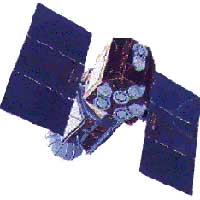
The Extreme Ultraviolet Explorer (EUVE) burned up in the Earth's atmosphere on January 30th.
Courtesy NASA/EUVE.
On January 31, 2001, the Extreme Ultraviolet Explorer (EUVE) satellite was shut down and put into hibernation mode, a victim of a dwindling NASA budget. One year later the craft ended its life completely, burning up upon reentry into Earth's atmosphere over central Egypt.
EUVE was a key component of NASA's space telescope fleet, filling the extreme-ultraviolet wavelength niche. From its launch on June 7, 1992, until its decommissioning last year, EUVE was "never out of science mode for more than a couple of days," says Brett Stroozas (University of California, Berkeley). "It's been a great spacecraft." NASA extended the mission's 3-year lifespan twice, and early last year scientists led a failed letter-writing campaign to persuade NASA to continue the mission further.
 0
0
Comments
You must be logged in to post a comment.